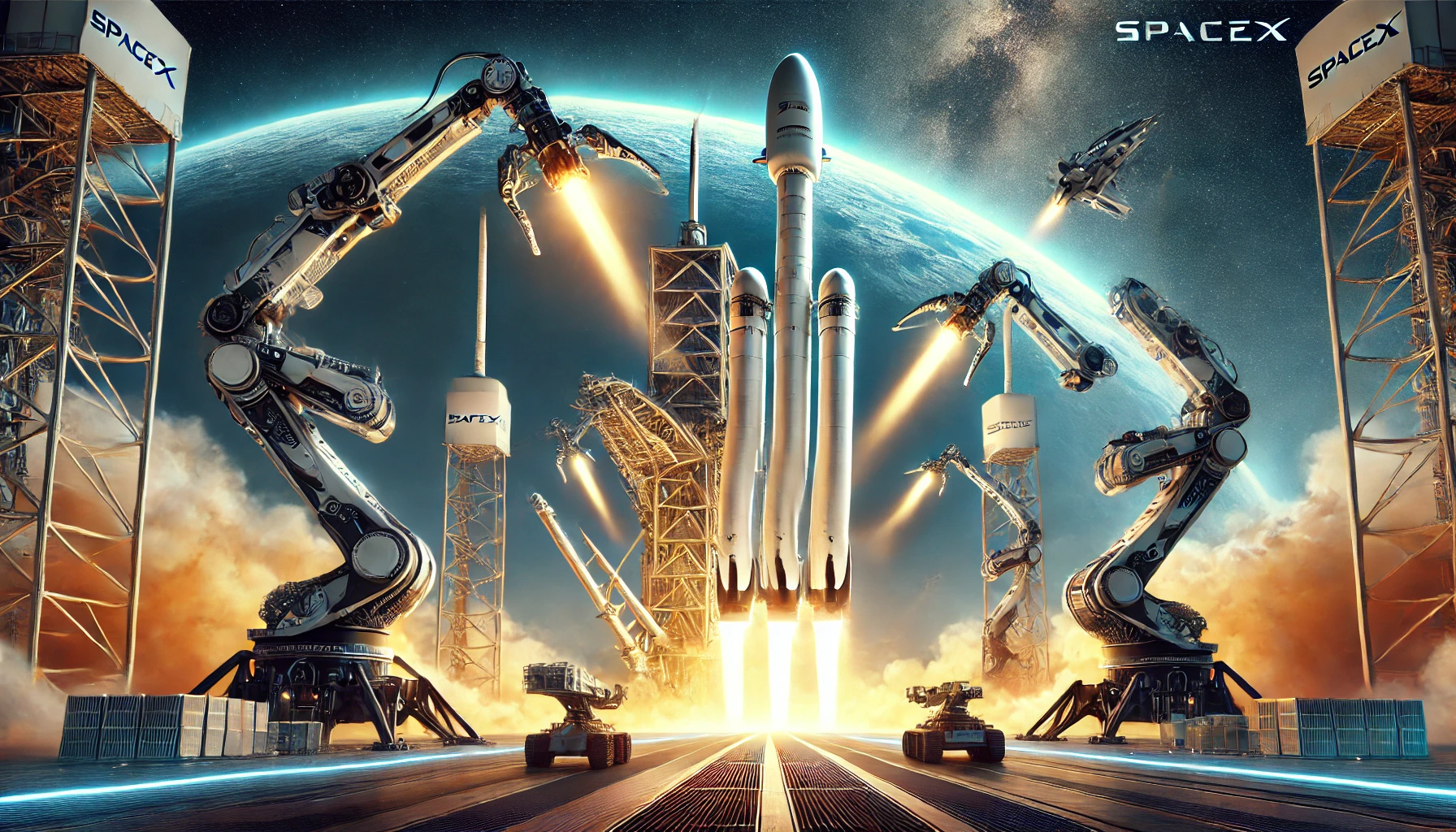Inside SpaceX’s Starship: The Engineering Marvel Behind Super Heavy Boosters and Mechazilla
SpaceX continues to push the boundaries of space exploration with innovations that are nothing short of revolutionary. Elon Musk’s vision for SpaceX Starship, combined with cutting-edge reusable rocket technology, is positioning the company as a leader in making space travel more cost-effective and accessible. One of the most intriguing recent developments is the integration of the Super Heavy booster catch system, which will use massive chopstick-like arms (known as SpaceX Mechazilla) to recover rockets directly at the launch site. This innovation, combined with the Starship booster catch mechanism, is a significant leap forward in achieving rapid, reusable launches.
In this blog, we’ll explore how these engineering marvels—Starship, Super Heavy booster, Mechazilla, and reusable rocket technology—are reshaping the future of space exploration, and we’ll also dive into how SpaceX is preparing for its Mars mission.
SpaceX Starship and the Super Heavy Booster: A Game-Changing Combination
At the heart of SpaceX’s space exploration goals is the SpaceX Starship, a fully reusable spacecraft designed to carry both crew and cargo to a variety of destinations, including the Moon, Mars, and even beyond. This spacecraft, standing 400 feet tall when paired with its Super Heavy booster, is the most powerful rocket ever builtNASASpaceFlight.com.
The Super Heavy booster is crucial to the Starship’s ability to achieve orbit. This powerful first stage is designed to propel Starship out of Earth’s atmosphere, after which it returns to Earth for reuse. Traditionally, first-stage boosters have been either discarded or required ocean landings, as seen with the Falcon 9 rocket. However, the Starship booster catch system will allow SpaceX to catch the Super Heavy booster mid-air using the innovative Mechazilla systemSpace.com.
Key Features of Super Heavy and Mechazilla
- Super Heavy booster: Capable of generating over 16 million pounds of thrust, it will carry Starship into orbit before returning to Earth for a controlled landing.
- Mechazilla arms: The “chopstick” arms on the SpaceX launch site tower will attempt to catch the returning booster, allowing for quick refurbishment and rapid reuse.
By catching the booster using the Mechazilla system, SpaceX hopes to drastically reduce the time between launches, making the Starship system more like an airliner—capable of rapid turnaround between flights.
The Mechazilla Booster Catch System: Redefining Reusability
The SpaceX Mechazilla system represents a bold approach to rocket recovery. Traditionally, rockets either splash down in the ocean or land on platforms, as seen with the Falcon 9’s impressive yet resource-intensive recovery system. The Starship booster catch system, however, takes a different route. SpaceX’s plan is to catch the Super Heavy booster using the Mechazilla arms, which would grab the rocket before it lands. This means no landing legs, no droneships, and—most importantly—no time wasted in retrieving the rocket.
Elon Musk confirmed this ambitious plan in June 2024, stating that the next Starship test flight could involve a full-scale attempt to catch the booster using the Mechazilla armsSpace.com. The arms, attached to the SpaceX launch site tower in Texas, were seen closing around a stationary Super Heavy booster during a recent test. If this technique proves successful, it could drastically cut costs and reduce the time between launches, bringing Musk’s vision of reusable rockets one step closer to reality.
Learn more about the physics behind SpaceX’s reusable rockets by visiting Space.com.
Elon Musk’s Vision for SpaceX and Mars
Elon Musk’s Starship is not just another launch vehicle; it’s designed to fulfill Musk’s dream of making humanity a multiplanetary species. The SpaceX Mars mission is the ultimate goal for the Starship program, with plans to use the massive vehicle to transport humans to Mars in the near future. The reusable rocket technology built into Starship is crucial for the success of this endeavor, as it will allow SpaceX to send repeated missions to Mars without having to manufacture a new spacecraft for each journey
How Reusable Rocket Technology is Paving the Way to Mars
SpaceX has already proven its capability with reusable rockets through its Falcon 9 program, which has completed numerous missions where the first stage of the rocket is recovered for reuse. The Super Heavy booster takes this concept even further, with both the booster and the Starship designed to be fully reusable.
Key Benefits of Reusability:
- Cost-efficiency: Building a new rocket for every mission is prohibitively expensive. By making rockets reusable, SpaceX drastically reduces the cost per launch.
- Sustainability: Reusability reduces the waste associated with space launches, contributing to a more sustainable approach to space exploration.
- Rapid launch cadence: The Starship booster catch system, enabled by Mechazilla, is designed to allow for rapid reusability, meaning SpaceX can launch more missions with shorter intervals between flights
Elon Musk has publicly stated that Starship’s reusability is critical for the success of the SpaceX Mars mission. The idea is to use Starship to send multiple payloads, including humans, to Mars at a fraction of the current cost. With Starship and Super Heavy booster reusability, SpaceX hopes to create a transport system that makes regular travel to Mars feasible.
Explore more about SpaceX’s vision for Mars exploration and educational resources at Regent Studies.
Starship Test Flights: Learning with Every Launch
The road to fully operational SpaceX Starship missions has been filled with test flights, each providing valuable insights. To date, SpaceX has conducted four Starship test flights, each improving on the last. The initial test flights were critical for testing the rocket’s basic flight capabilities, while more recent tests have focused on achieving successful stage separation and controlled landings.
The upcoming test flights will aim to catch the Super Heavy booster using Mechazilla, further refining the process for eventual commercial missions and long-duration space flights. The SpaceX launch site in Boca Chica, Texas, has become the focal point of these efforts, with the site evolving to support frequent test flights and launches
What’s Next for Starship?
The next major milestone for Starship is to achieve a full launch and recovery using the booster catch system. If successful, it will mark the first time a rocket of this size and power has been fully reused after launch. Following that, the focus will shift to integrating crewed missions, cargo delivery, and eventually, missions to the Moon and Mars.
SpaceX is also working with NASA to use Starship as part of the Artemis program, aiming to land astronauts on the Moon as early as 2025. With these upcoming missions, Starship could become the workhorse for not just SpaceX, but for NASA and other space agencies.
SpaceX’s Future in Space Exploration
SpaceX’s Starship represents a monumental leap forward in space exploration. With the integration of reusable rocket technology, the Super Heavy booster, and the innovative Mechazilla booster catch system, the dream of frequent, affordable space travel is becoming a reality. As the company continues to test and refine these systems, the vision for a SpaceX Mars mission is growing closer. Elon Musk’s commitment to making humanity a multiplanetary species is driving these advancements, and each successful test flight brings us one step nearer to that goal.
As Starship test flights continue, and with the promise of Mechazilla catching Super Heavy boosters, it’s clear that SpaceX is on the brink of revolutionizing the space industry.
For more insights on SpaceX’s journey to Mars and the future of reusable rockets, visit Regent Studies.




